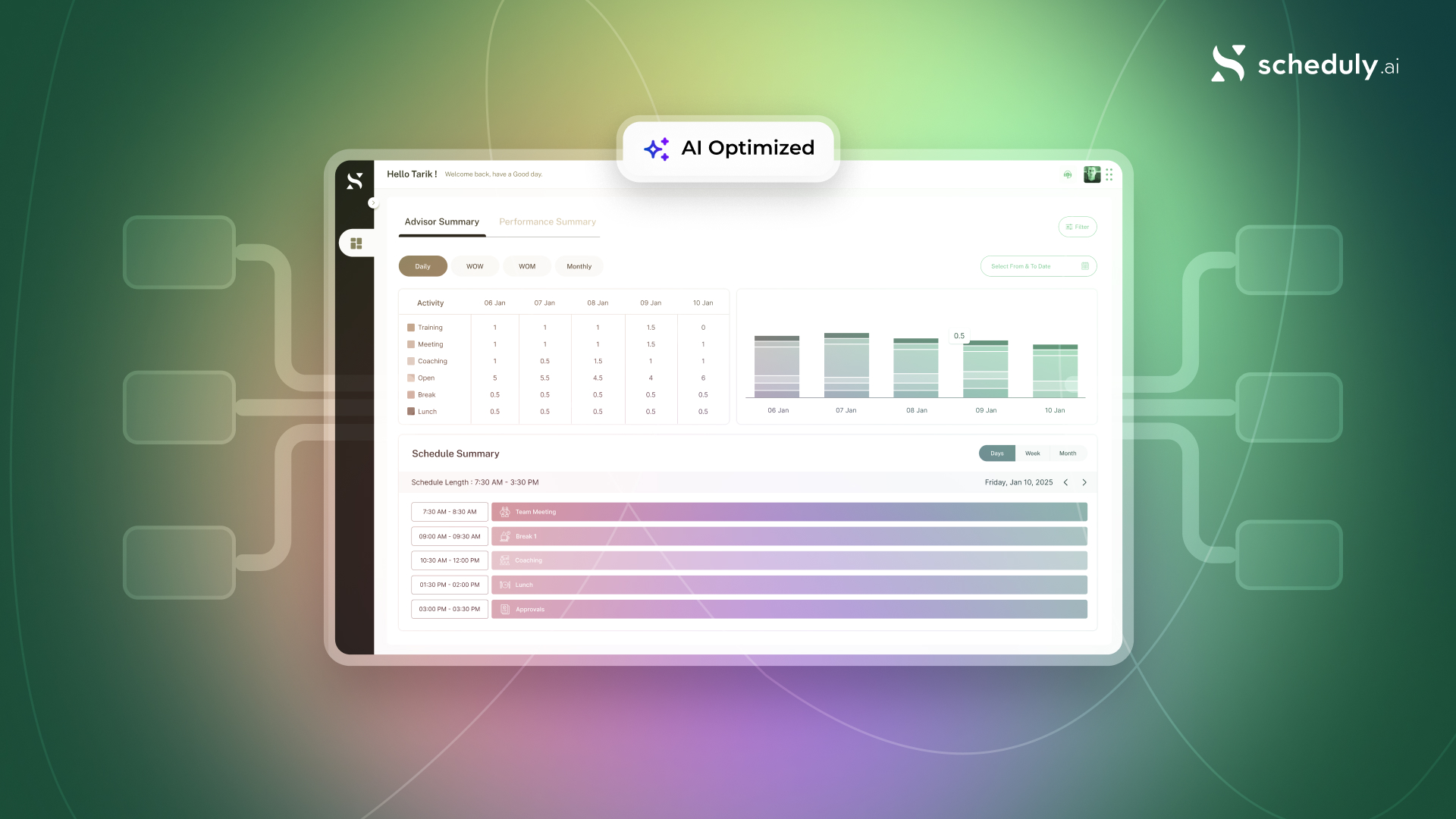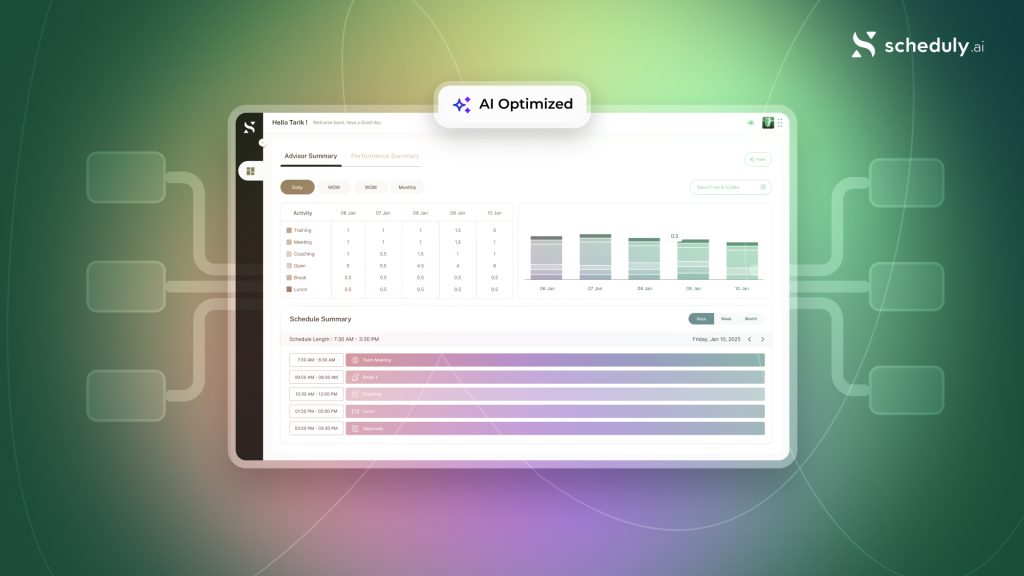When your high-performing agent starts missing shifts and CSAT falls, the warning sign is clear: burnout from broken scheduling is costing you more than headcount.
In high-volume environments like contact centers, outdated shift planning is no longer beneficial, especially now, when markets are highly sensitive. That’s why leaders are shifting to AI shift scheduling, because it’s everything an enterprise needs.
From forecasting demand, prioritizing fairness, and actively preventing fatigue, AI shift scheduling platform does it all. And this blog dives right into how AI-powered WFM solutions reduce burnout and improve productivity.
Why Traditional Shift Planning Fails
In numerous organizations, burnout is considered a performance or engagement issue. But, in reality it’s a planning failure, residing inside a spreadsheet.
Additionally, managers are able to create a full roster with traditional techniques, but they’re inefficient in accounting for human limits, operational complexity, and day-to-day agility. That’s why the traditional shift planning system fails. Similarly, there are more reasons behind it, such as:
#1: They Assume Demand is Predictable
In sectors like contact centers and healthcare, demand is highly volatile based on seasonality, incidents, and public behavior. In such scenarios, the traditional scheduling system fails, as they rely on outdated forecasts or just flat headcount ratios.
#2: They Don’t Account for Cognitive Load
Traditional scheduling systems mean static schedules, which treat every employee as same.
For example: A contact center agent handling high volumes of escalated calls during peak hours will burn out faster than someone handling routine email support. The load of managing frustrated customers, back-to-back calls, and tight performance metrics adds up fast. As a result, agents quit, attrition rises, and both ROI and ROX get impacted.
#3: Top Performers Get Scheduled Into Burnout
The phrase “they can handle it” is one of the significant root causes to burnout. When most reliable people are repeatedly assigned to peak hours, weekend shifts, and emergency coverage, they burn out or quit. And their replacements are rarely ready.
#4: Last-Minute Changes are the Norm
Legacy scheduling system don’t adapt in real-time. When someone calls in sick or shift overextends, managers are not able to rebalance the day. It leads to rushed decisions, and doubles shifts, especially in contact center environment. As a result, reduced morale, and increased error rate.
#5: Employees are Treated as Slot, Not People
Filling slots and completing the rooster is no longer best practice in comparison to AI shift scheduling. It doesn’t respect employee preferences, skill levels, and recovery needs. And when employees have no control over their schedule, their engagement drops and so does productivity.
AI Shift Scheduling: Key Features and Results Achieved

Source: McKinsey
AI shift scheduling is not only dynamically managing the workforce. It’s about transforming the entire WFM cycle and ensure that it adapts to demand, fatigue, and fairness requirements.
Below are the top 5 features of AI shift scheduling and what results they help enterprises to achieve:
#1: Demand Forecasting with Precision
AI models don’t rely on averages. They analyze historical data, seasonality, workload patterns, and external factors while forecasting the demand. It helps the organizations to plan proactively instead of reactively.
Results achieved:
- Accurate headcount, even during seasonal spikes
- Overstaffing and understaffing prevention
- Headcount recommendations per hour/day/site
#2: Fatigue and Wellness Detection
Employee wellness is now an integrated part of a good working environment and AI shift scheduling aids in optimizing it. AI-powered systems evaluate emotional load, schedule intensity, shift patterns, and fatigue risk.
All such factors results in recommending break hours, recovery days, and shift deferrals.
Results achieved:
- Enhanced productivity, while reducing burnout
- Personalized shift limits based on role stress level
- Reliable recovery scheduling, before burnout escalates
Ready to End Burnout with Smarter Scheduling?
#3: Preference-Based Scheduling
Whether it’s the customer experience or the employee experience, personalization is expected, and AI shift scheduling helps to achieve it. The advanced algorithms take input from employees about their preferred hours, days off and consider their seniority, skills and even productivity metrics to create a schedule.
Results achieved:
- Higher shift acceptance and lower last-minute dropouts
- Stronger work-life balance and increased productivity
- Scheduling equity across teams
#4: Dynamic Shift Rebalancing
It isn’t a myth, but reality, that AI shift scheduling makes workforce management smarter, and streamlined. It monitors real-time attendance, call volume, and absences to rebalance shifts on the go. Additionally, it can also swap roles, reassign tasks, and even activate backup staff instantly.
Results achieved:
- Real-time response to disruptions
- Operational continuity without overloading employees
- No need for managers to manually reshuffle shifts
#5: Compliance-Driven Automation
With AI workforce management tools, like Scheduly.ai, you don’t have to fret about compliance. The AI tools ensure adherence to labor regulations, union contracts, and internal HR policies. Moreover, you can configure customer rules, such as mandatory rest periods, holiday pay, meal breaks, and more.
Results achieved:
- Automatic schedule validation against compliance framework
- Reduced legal risk and workforce disputes
- Confidence in union and labor board audits
Here’s an additional differentiation table to understand how AI optimized scheduling is better than the traditional approach.
| Feature | Traditional Scheduling | AI-Optimized Scheduling |
|---|---|---|
| Forecasting accuracy | Low | High |
| Fatigue prevention | Manual oversight | Automated |
| Employee preference integration | Rare or partial | Fully personalized |
| Real-time shift adaptation | Limited | High |
| Compliance monitoring | Manual + reactive | Automated + proactive |
Why Consider Scheduly.ai for AI Shift Scheduling Purposes
Scheduly.ai is built to streamline workforce management for enterprises. This AI-powered platform automates complex shift planning by adapting to real-time updates, and ensuring fair, compliant scheduling. In addition, it helps in reducing employee burnout, improve retention, and eliminate guesswork.
You can utilize it anywhere, from managing hospital staff to thousands of agents in a global contact center. And, if you’re scaling fast, stuck in excel sheets, and analyzing a high attrition rate, then Scheduling.ai is your solution to deal with all.
Furthermore, Scheduly.ai offers:
- AI-based demand forecasting
- Mobile-first ESS tools
- Compliance automation
- Real-time dashboard
- Plug-and-play integrations
Still Using Spreadsheets to Manage Shifts?
Conclusion
Employee burnout is not an HR issue; it’s more of an operational issue, due to lack of planning and usage of traditional tools and mechanisms. That’s why AI shift scheduling is now the standardized way to manage the workforce at scale.
From contact centers, hospitals, retail chains, warehouses, and any other enterprise, AI shift scheduling is helping businesses to align goals with human capacity. It’s 2025, and if you’re still using spreadsheets, it’s time to rethink and transform your workforce resilience with AI scheduling.
FAQs
AI shift planning uses machine learning to create dynamic employee schedules based on real-time demand and individual preferences, ensuring fairness and efficiency while reducing manual workload.
Yes. AI shift scheduling platforms help to detect fatigue and balance workload, which results in adding rest time in shift. As a result, employees regain work-life balance, leading to lower burnout and attrition rate.
Industries with high volume and fluctuating demand, like contact centers, healthcare, logistics, and retail benefit most. AI adapts schedules to peaks and reduces last-minute chaos.


